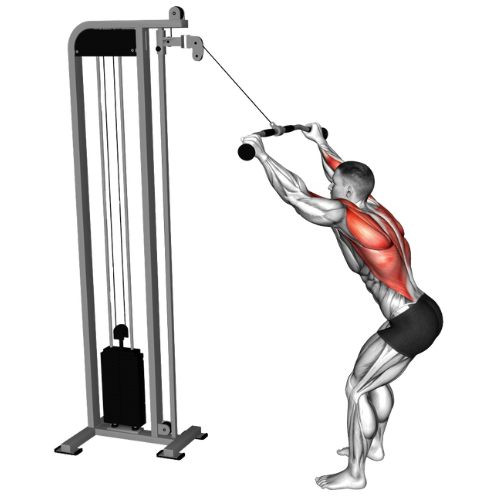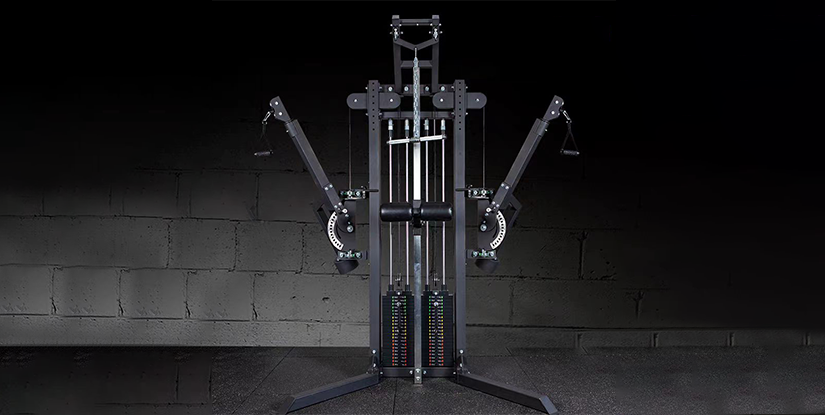I kept hearing about the straight arm lat pull down, but honestly, I didn’t think much of it—until my lats just weren’t growing like I wanted. They looked decent, sure, but not that wide, winged-out look I was chasing. Then I stumbled across a thread where someone called it a “lat cheat code.” Spoiler: it actually made a difference.
How the Straight Arm Lat Pulldown Actually Works
First time I tried the straight arm lat pulldown? I honestly felt super awkward. Like, am I doing a weird triceps pushdown or trying to fly? But after a few reps, it started to click.
Here’s how I set it up and got the most out of it:
- Step 1: I grabbed the straight bar attachment, set the pulley up high—like all the way up.
- Step 2: Took a couple steps back from the functional trainer machine. Not too far, just enough to get tension right off the start.
- Step 3: Slight bend in the elbows—not locked out. That was key.
- Step 4: So, I dragged the bar down in this clean arc—kinda like I was trying to wrap my arms around a giant beach ball or something.
- Step 5: Then I paused right at my thighs, gave the lats a solid squeeze, and slowly let it float back up nice and controlled.
Some cues that really helped me:
- “Soft elbows” – don’t go stiff-armed or it turns into a shoulder-destroyer.
- “Big stretch at the top” – I leaned slightly forward to really feel that lat stretch.
- “Drive with your lats, not your arms” – sounds weird, but once I visualized pulling with my armpits (lol), it hit differently.
Overall, once I nailed the form, it felt like a clean isolation move that torched my lats in a good way. Definitely not as flashy as rows or pull-ups, but super solid once you get the hang of it.

What Muscles It Works and What I Felt
Alright, so here’s the deal—straight arm lat pulldown absolutely lit up my lats. Like, no doubt about it. After a few solid sets, I could feel that deep lat burn that rows and regular pulldowns don’t always hit the same way.
But that’s not all I noticed:
- Rear delts? Yeah, they got in on the action too, especially toward the bottom of the pull.
- Triceps? A little, but only if I wasn’t careful. If I bent my elbows too much, it started turning into a weird triceps thing.
- Core? Surprisingly, I had to brace hard to keep everything steady. So bonus core work, I guess.
Compared to regular lat pulldowns, this just felt… cleaner? More focused. Less upper trap takeover. No cheating with momentum. Just me, the cable, and my lats doing all the heavy lifting (literally).
Anyway, it was a different vibe, but in a good way—especially if you’re trying to actually isolate your lats in a busy gym setting without hogging three machines.
Benefits I Noticed After Adding It In
Honestly, once I started doing the straight arm lat pulldown consistently, my back workouts just felt better overall. I didn’t expect it to make that much of a difference, but it did—big time.
- First off, my lats started firing way better on rows and pullups. Before, I’d kinda muscle everything with my arms or traps. But after adding this in? Boom—straight to the lats.
- Also, I could actually feel where the tension was supposed to be. Especially on back day when everything tends to blend together, this kept me dialed in.
- It’s killer as a warmup too. Light weight, slow reps, just to wake up the lats before hitting heavier stuff.
- And as a finisher? Forget it. Total lat burnout. In the best way.
So yeah, it’s not just a fluff movement. Whether I’m hitting rows, pullups, or even deadlifts later on, this keeps my lats locked in and doing their job.
When I Use the Straight Arm Lat Pulldown Now
At this point, the straight arm lat pulldown is just a regular part of my back days. I don’t always lead with it, but I use it in a few key ways depending on the day.
- If it’s a light day, I’ll toss it in early to get my lats fired up. It helps me lock in that mind-muscle connection before moving to bigger lifts.
- On heavy back days? I usually save it for the end as a solid finisher. Light weight, slow reps, full stretch—it burns in the best way.
- Is it for max strength? Nah, not really. But for muscle activation and control? It’s gold.
Basically, I use it whenever I want to really feel the lats working, without wrecking my CNS.
Anyone else been sleeping on the straight arm lat pulldown? Drop a comment—when did you start adding this move to your back day at the gym?
FAQs about Straight Arm Lat Pull Down
The straight arm lat pulldown primarily targets the latissimus dorsi muscles, which are the large muscles on your back that give you that “V” shape. Additionally, it engages the teres major, triceps, and core stabilizers. This exercise is excellent for not only developing back strength but also improving shoulder mobility and stability. The isolation of the lats makes it a great exercise for enhancing other lifts like the bench press and deadlift because it strengthens your back and enhances your overall upper body performance.
The effectiveness of a lat pulldown can vary depending on individual fitness goals. However, the wide grip lat pulldown is often considered the most effective variation for targeting the upper lats, giving the back width. While the close grip pulldown is better for targeting the lower lats, when it comes to pure lat activation, the wide grip lat pulldown holds its ground as a staple in back workouts. Incorporating variations such as neutral grip or underhand grip can also contribute to an overall balanced development of the back muscles.
For men’s health, the straight arm pulldown provides significant benefits that extend beyond muscle hypertrophy. By strengthening the lats and surrounding musculature, it supports overall posture, reducing the risk of back injuries and alleviating lower back pain. The exercise encourages shoulder mobility and stability, essential for athletes and individuals involved in physical labor. Additionally, incorporating straight arm pulldowns into a workout routine aids in enhancing the overall aesthetics of the back and contributes to a balanced upper body muscular structure.
To perform a straight arm pullover, you’ll need a dumbbell or a barbell and a bench. Begin by lying on your back on a bench, holding the weight above your chest with straight arms. Your feet should be flat on the floor. Slowly lower the weight overhead, keeping your arms straight but not locked, until your arms are parallel to the floor or you feel a stretch in your chest and lats. Pause for a moment, then engage your lats and chest to raise the weight back to the starting position. Maintain control throughout the movement and keep your core engaged to stabilize your body. Repeat the exercise for the desired number of repetitions and ensure you are using a weight that allows you to maintain proper form.

Hi, I’m the editor here at Leadman Fitness. We’re a manufacturer focused on producing top-quality barbells, plates, kettlebells, dumbbells, and strength training gear. I’ve been into sports and fitness for years, and I know my way around all kinds of gym equipment—both from using it and helping create it.
I spend a lot of time understanding the real problems people run into in the gym—whether it’s beginners trying to pick the right gear or experienced lifters looking for something more durable. I stay in close touch with our production team and talk directly with other equipment makers, so we’re always improving based on what real lifters and coaches are looking for.
What I share comes from hands-on experience—stuff that actually helps people train better, not just in theory, but in real gyms.
